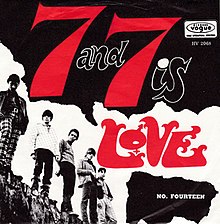7 and 7 Is
| "7 and 7 Is" | ||||
|---|---|---|---|---|
 | ||||
| Single by Love | ||||
| from the album Da Capo | ||||
| B-side | "No. Fourteen" | |||
| Released | July 1966 | |||
| Recorded | June 17 and 20, 1966 | |||
| Studio | Sunset Sound Recorders, Hollywood, California | |||
| Genre | ||||
| Length | 2:15 | |||
| Label | Elektra | |||
| Songwriter(s) | Arthur Lee | |||
| Producer(s) | Jac Holzman | |||
| Love singles chronology | ||||
| ||||
"7 and 7 Is" is a song written by Arthur Lee and recorded by his band Love on June 17 and 20, 1966, at Sunset Sound Recorders in Hollywood. It was produced by Jac Holzman and engineered by Bruce Botnick.
The song was released as the A-side of
Background and development
Lee's original version of the song was a slow folk song in the style of Bob Dylan.[2] Its arrangement developed as the band experimented in the studio.[7] Bassist Ken Forssi had received a bass fuzz effect unit from an endorsement deal the band had signed with Vox, and Lee suggested Forssi use it on "7 and 7 Is". Lead guitarist Johnny Echols recalled: "We started playing [with it] and at first it sounded strange, but Kenny started doing this sliding bass thing with it. As we played it we could hear that this was something different, something new."[8]
Recording
Love recorded "7 and 7 Is" on June 17 and 20, 1966, at Sunset Sound Recorders,[9] with Jac Holzman producing and Bruce Botnick engineering.[10] The fuzz bass was ultimately abandoned as it overpowered the other instruments, but Forssi was able to achieve a similar sound with the feedback caused by his semi-acoustic Eko bass. Echols also used feedback, as well as extensive reverb and tremolo,[11] saying he had wanted to use a surf guitar effect in a different context.[9]
The sessions were tumultuous due to the song's fast and intense drum part, with Lee and drummer Alban "Snoopy" Pfisterer taking turns trying to accomplish it. Pfisterer later said: "The session was a nightmare ... I had blisters on my fingers. I don't know how many times I tried to play that damn thing and it just wasn't coming out. Arthur would try it; then I'd try it. Finally I got it. He couldn't do it."[12] Echols praised it as Pfisterer's best performance.[11] Estimates in the number of takes the song required range from 20 to 60;[13] however, most of these were only false starts.[9] The song took 4 hours to record according to Echols, who also claimed that the session took longer due to Holzman and Botnick objecting to the band's experimentation: "they kept stopping us, saying, 'It's feeding back!' We'd say, 'It's supposed to feed back.'"[14]
In what has been called a "flirtation" with musique concrète,[15] the track climaxes with the sound of an atomic explosion before a peaceful conclusion, in a blues form, which then fades out.[6] Botnick said the explosion was taken from a sound effects record and may have been a gunshot slowed down. During live performances, Echols would recreate the sound by kicking his amplifier with the reverb turned all the way up.[16]
Release and reception
Elektra Records issued "7 and 7 Is" in July 1966, backed with "No. Fourteen", an outtake from Love's debut album.[17] It entered the Billboard Hot 100 on July 30 and spent 10 weeks on the chart, peaking at number 33 on September 24.[18] It was the highest-charting single of the band's career.[16] Elektra released the band's second album, Da Capo, in November,[19] with "7 and 7 Is" sequenced as the fourth track, between "¡Que Vida!" and "The Castle".[20]
Music critic
Covers
Described as
Notes
- Rosa Lee Brooks) and "A Message to Pretty" from Love's self-titled debut album.[4]
References
Citations
- ISBN 978-0-571-28198-5.
- ^ a b Sandoval 2002, p. 3.
- ^ Einarson 2010, pp. 52, 116; Bronson, Gallo & Sandoval 1995, p. 15.
- ^ Einarson 2010, p. 52.
- ^ Bronson, Gallo & Sandoval 1995, p. 15.
- ^ a b Hoskyns 2002, pp. 47–49.
- ^ Einarson 2010, pp. 116–117; Sandoval 2002, p. 4.
- ^ Einarson 2010, p. 116.
- ^ a b c Sandoval 2002, p. 4.
- ^ Einarson 2010, pp. 116, 118.
- ^ a b Einarson 2010, p. 117.
- ^ Einarson 2010, pp. 116–117.
- ^ Einarson 2010, p. 117: 20; Brooks 1997, p. 35: 60.
- ^ Einarson 2010, pp. 117–118.
- ^ Pouncey 2002, p. 157.
- ^ a b Einarson 2010, p. 118.
- ^ Bronson, Gallo & Sandoval 1995, p. 29.
- ^ "Chart History: Love". Billboard. Archived from the original on 29 January 2023. Retrieved 25 February 2023.
- ^ Einarson 2010, p. 145.
- ^ Brooks 1997, pp. 34–35.
- ^ Christgau, R. (June 1967). "Columns". Esquire. Retrieved 2012-07-06.
- ^ "CashBox Record Reviews" (PDF). Cash Box. July 16, 1966. p. 36. Retrieved 2022-01-12.
- ISBN 978-0-9915892-1-0.
- ISBN 9780313338465.
- ^ Steininger, Alex (July 30, 2020). "Jared Louche and the Aliens: Covergirl". In Music We Trust (26). Retrieved July 30, 2020.
Sources
- Bronson, Harold; Gallo, Phil; Rhino Records. R2 73500.
- Brooks, Ken (1997). Arthur Lee: Love Story. Andover, Hampshire: Agenda Books. ISBN 1-899882-60-X.
- ISBN 978-1-906002-31-2.
- ISBN 978-1-84195-315-1.
- Pouncey, Edwin (2002). "Rock Concrète". In Young, Rob (ed.). Undercurrents: The Hidden Wiring of Modern Music. London: ISBN 978-0-8264-6450-7.
- Sandoval, Andrew (2002). Da Capo (Liner Notes). Love. Carlin Music Corporation. 8122 73604-2.
